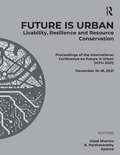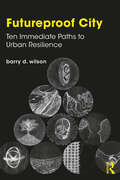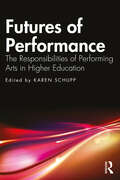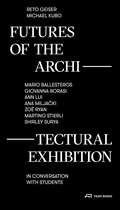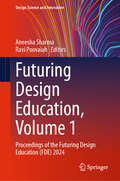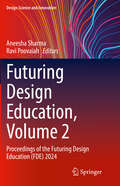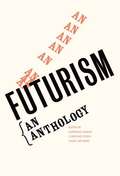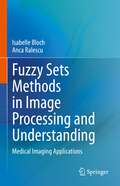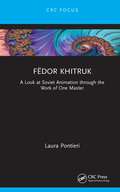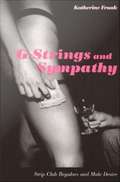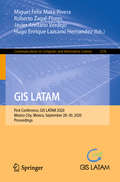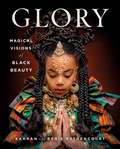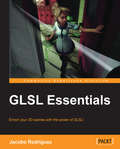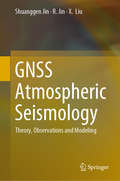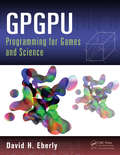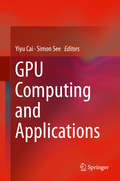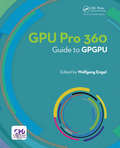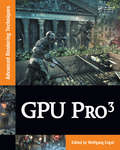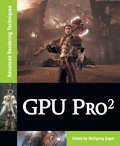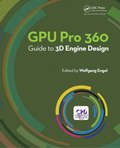- Table View
- List View
Future is Urban: Proceedings of the International Conference on FUTURE IS URBAN: Livability, Resilience and Resource Conservation (ICFU 2021), December 16–18, 2021
by R. Parthasarathy Utpal SharmaCities have played an important role in our lives since the dawn of civilization. However, cities are slowly becoming overwhelmed and therefore intervention is desirable towards green, blue and egalitarian nature. Even with current urban issues, we must rise to the occasion as professionals to create cities that are social, cities that take care of the environment, and cities that are digital. Increased citizen participation is indispensable in this process. The ‘International Conference on Future is Urban (IFCU’ 21) Dec 16-18, 2021, Ahmedabad, India’, takes into account Livability, Resilience & Resource Conservation for planning Future and cities in future.
Futurenatural: Nature, Science, Culture (FUTURES: New Perspectives for Cultural Analysis)
by Tim Putnam George Robertson Melinda Mash Lisa Tickner Jon Bird Barry CurtisWe are living in an age when 'nature' seems to be on the brink of extinction yet, at the same time, 'nature' is becoming increasingly ubiquitous and unstable as a category for representation and debate.Futurenatural brings together leading theorists of culture and science to discuss the concept of 'nature' - its past, present and future. Contributors discuss the impact on our daily life of recent developments on biotechnologies, electronic media and ecological politics. Increasingly, scientific theories and models have been taken up as cultural metaphors that have material effects in transforming 'ways of seeing' and 'structures of feeling'.The book addresses the issue of whether political and cultural debates about the body and environment can take place without reference to 'nature' or the 'natural'. This collection considers how we might 'think' a future developing from emergent scientific theories and discourses. What cultural forms may be produced when new knowledges challenge and undermine traditional ways of conceiving the 'natural'.
Futureproof City: Ten Immediate Paths to Urban Resilience
by Barry D. WilsonThe Futureproof City creates adaptability and resiliency in the face of the unknown challenges resulting from technological change, population explosion, global pandemic, and environmental crisis. A paradigm shift is urgently required in the means of conceiving, delivering, and managing city development to create better places to live. This book brings to the fore many new solutions currently being proposed and piloted globally, identifying ten key areas affecting the physical fabric of our cities where governments, planners, investors, and the individuals responsible for shaping lives can refocus their understanding, priorities, and funding in order to more effectively utilise the limited financial, natural, and time resources available. It will be key reading for every policy maker and professional working in sustainability, development, technology, health and welfare, investment, and risk issues in cities today.
Futures of Performance: The Responsibilities of Performing Arts in Higher Education
by Schupp KarenFutures of Performance inspires both current and future artists/academics to reflect on their roles and responsibilities in igniting future-forward thinking and practices for the performing arts in higher education. The book presents a breadth of new perspectives from the disciplines of music, dance, theatre, and mediated performance and from a range of institutional contexts. Chapters from teachers across various contexts of higher education are organized according to the three main areas of responsibilities of performing arts education: to academia, to society, and to the field as a whole. With the intention of illuminating the intricacy of how performing arts are situated and function in higher education, the book addresses key questions including: How are the performing arts valued in higher education? How are programs addressing equity? What responsibilities do performing arts programs have to stakeholders inside and outside of the academy? What are programs’ ethical obligations to students and how are those met? Futures of Performance examines these questions and offers models that can give us some of the potential answers. This is a crucial and timely resource for anyone in a decision-making position within the university performing arts sector, from administrators, to educators, to those in leadership positions.
Futures of Reproduction
by Catherine MillsIssues in reproductive ethics, such as the capacity of parents to 'choose children', present challenges to philosophical ideas of freedom, responsibility and harm. This book responds to these challenges by proposing a new framework for thinking about the ethics of reproduction that emphasizes the ways that social norms affect decisions about who is born. The book provides clear and thorough discussions of some of the dominant problems in reproductive ethics - human enhancement and the notion of the normal, reproductive liberty and procreative beneficence, the principle of harm and discrimination against disability - while also proposing new ways of addressing these. The author draws upon the work of Michel Foucault, especially his discussions of biopolitics and norms, and later work on ethics, alongside feminist theorists of embodiment to argue for a new bioethics that is responsive to social norms, human vulnerability and the relational context of freedom and responsibility. This is done through compelling discussions of new technologies and practices, including the debate on liberal eugenics and human enhancement, the deliberate selection of disabilities, PGD and obstetric ultrasound.
Futures of the Architectural Exhibition
by Reto Geiser Michael KuboThis book records a critical discussion of individual approaches to the representation of space in a museum through a series of conversations. Architecture and design exhibitions have long been important public sites of broadcasting, experimentation, position-taking, and the interrogation of fundamental aspects of the designed environment. Just as individual exhibitions have constituted key benchmarks within the disciplinary history of architecture, the representation and display of space through exhibitions has operated historically as a crucial medium for shaping and embodying broader cultural attitudes toward the design of the built world. In recent years, the specific formats and challenges of exhibiting architecture and design, both built and speculative, have often been used as critical devices for identifying, communicating, and convening the public around shared matters of concern. These have increasingly included urgent questions of equity and justice, labor, gender, race, class, community, and lifestyle in relation to spatial issues of density, economy, policy, infrastructure, climate, and sustainability.
Futuring Design Education, Volume 1: Proceedings of the Futuring Design Education (FDE) 2024 (Design Science and Innovation)
by Ravi Poovaiah Aneesha SharmaThis book presents select proceedings of the two-day conference titled Futuring Design Education (FDE 2024), and it examines the transformation of design knowledge, the evolving spaces of learning, and the ecosystems of teaching and learning. The topics covered include the pedagogical model of design education, the experiments, and technological advances that impact design education. The book also discusses the roles and challenges of learning spaces, remote learning in digital spaces, and synchronous and asynchronous learning tools. The book will also look at the social contexts in design pedagogy, cultural affiliations and alignments and will allude to any new learning frameworks for design education. The book can be a valuable reference for design educators, design researchers, and professionals interested in design education.
Futuring Design Education, Volume 2: Proceedings of the Futuring Design Education (FDE) 2024 (Design Science and Innovation)
by Ravi Poovaiah Aneesha SharmaThis book presents select proceedings of the two-day conference titled Futuring Design Education (FDE 2024), and it examines the transformation of design knowledge, the evolving spaces of learning, and the ecosystems of teaching and learning. The topics covered include the pedagogical model of design education, the experiments, and technological advances that impact design education. The book also discusses the roles and challenges of learning spaces, remote learning in digital spaces, and synchronous and asynchronous learning tools. The book will also look at the social contexts in design pedagogy, cultural affiliations and alignments and will allude to any new learning frameworks for design education. The book can be a valuable reference for design educators, design researchers, and professionals interested in design education.
Futurism: An Anthology
by Lawrence Rainey Christine Poggi Laura WittmanIn 1909, F. T. Marinetti published his incendiary Futurist Manifesto, proclaiming, "We stand on the last promontory of the centuries!!" and "There, on the earth, the earliest dawn!" Intent on delivering Italy from "its fetid cancer of professors, archaeologists, tour guides, and antiquarians," the Futurists imagined that art, architecture, literature, and music would function like a machine, transforming the world rather than merely reflecting it. But within a decade, Futurism's utopian ambitions were being wedded to Fascist politics, an alliance that would tragically mar its reputation in the century to follow. Published to coincide with the 100th anniversary of the founding of Futurism, this is the most complete anthology of Futurist manifestos, poems, plays, and images ever to be published in English, spanning from 1909 to 1944. Now, amidst another era of unprecedented technological change and cultural crisis, is a pivotal moment to reevaluate Futurism and its haunting legacy for Western civilization.
Fuzzy Sets Methods in Image Processing and Understanding: Medical Imaging Applications
by Isabelle Bloch Anca RalescuThis book provides a thorough overview of recent methods using higher level information (object or scene level) for advanced tasks such as image understanding along with their applications to medical images. Advanced methods for fuzzy image processing and understanding are presented, including fuzzy spatial objects, geometry and topology, mathematical morphology, machine learning, verbal descriptions of image content, fusion, spatial relations, and structural representations. For each methodological aspect covered, illustrations from the medical imaging domain are provided. This is an ideal book for graduate students and researchers in the field of medical image processing.
Fëdor Khitruk: A Look at Soviet Animation through the Work of One Master
by Laura PontieriThis book is a first and long-awaited study of the directorial work of the animation master Fëdor Khitruk (1917–2012), an artist who formed in the tradition of classical cel animation only to break the conventions once he turned into a director; a liaison between artists and authorities; a personality who promoted daring films to be created in the Soviet Union dominated by socialist realism; and a teacher and supporter of young artists that continued to carry on his legacy long after the Soviet empire collapsed. Fëdor Khitruk: A Look at Soviet Animation through the Work of One Master reveals Khitruk’s mastery in the art of the moving image and his critical role as a director of films that changed the look of Soviet animation and its relation to the animation world within and beyond the Eastern Bloc. Based on archival research, personal interviews, published memoirs, and perceptive analyses of Khitruk’s production of films for children and adults, this study is a must-read for scholars in Soviet art and culture as well as readers fascinated by traditional animation art.
G-Strings and Sympathy: Strip Club Regulars and Male Desire
by Katherine FrankBased on her experiences as a stripper in a city she calls Laurelton--a southeastern city renowned for its strip clubs--anthropologist Katherine Frank provides a fascinating insider's account of the personal and cultural fantasies motivating male heterosexual strip club "regulars. " Given that all of the clubs where she worked prohibited physical contact between the exotic dancers and their customers, in G-Strings and Sympathy Frank asks what--if not sex or even touching--the repeat customers were purchasing from the clubs and from the dancers. She finds that the clubs provide an intermediate space--not work, not home--where men can enjoyably experience their bodies and selves through conversation, fantasy, and ritualized voyeurism. At the same time, she shows how the dynamics of male pleasure and privilege in strip clubs are intertwined with ideas about what it means to be a man in contemporary America. Frank's ethnography draws on her work as an exotic dancer in five clubs, as well as on her interviews with over thirty regular customers--middle-class men in their late-twenties to mid-fifties. Reflecting on the customers' dual desires for intimacy and visibility, she explores their paradoxical longings for "authentic" interactions with the dancers, the ways these aspirations are expressed within the highly controlled and regulated strip clubs, and how they relate to beliefs and fantasies about social class and gender. She considers how regular visits to strip clubs are not necessarily antithetical to marriage or long-term heterosexual relationships, but are based on particular beliefs about marriage and monogamy that make these clubs desirable venues. Looking at the relative "classiness" of the clubs where she worked--ranging from the city's most prestigious clubs to some of its dive bars--she reveals how the clubs are differentiated by reputations, dress codes, cover charges, locations, and clientele, and describes how these distinctions become meaningful and erotic for the customers. Interspersed throughout the book are three fictional interludes that provide an intimate look at Frank's experiences as a stripper--from the outfits to the gestures, conversations, management, coworkers, and, of course, the customers. Focusing on the experiences of the male clients, rather than those of the female sex workers, G-Strings and Sympathy provides a nuanced, lively, and tantalizing account of the stigmatized world of strip clubs.
GIMP 2.6 for Photographers
by Klaus GoelkerImage editing has become a crucial element in the photographic workflow. Image editing tools, most notably Photoshop, are usually sophisticated and deep applications, and are fairly expensive. The only open source tool in this market is the GIMP, which has developed into a powerful, multiplatform system running on Linux, Mac OS X, and Microsoft Windows. GIMP 2.6 for Photographers is a beginner's guide to the only open source image editing tool that provides a low-cost alternative to expensive programs such as Photoshop. Topics include the basics of image editing and simple adjustments, as well as advanced techniques using layers and masks, stitching panoramic images, and preparing high-quality black and white images. The most important editing functions are presented in individual, easy-to-follow workshops. GIMP 2.6 for Photographers has evolved from classroom materials that the author developed and taught in courses and workshops on image editing with the GIMP.
GIS LATAM: First Conference, GIS LATAM 2020, Mexico City, Mexico, September 28–30, 2020, Proceedings (Communications in Computer and Information Science #1276)
by Miguel Felix Mata-Rivera Roberto Zagal-Flores Javier Arellano Verdejo Hugo Enrique Lazcano HernandezThis book constitutes the refereed proceedings of the First GIS LATAM Conference, GIS LATAM 2020, held in September 2020. Due to the COVID-19 pandemic the conference was held online. The 9 full papers and 2 short papers were thoroughly reviewed and selected from 29 submissions. The papers are focused on the GIS applications in data analytics in spheres of health, environment, government, public, and education.
GLORY: Magical Visions of Black Beauty
by Kahran Bethencourt Regis BethencourtTHE INSTANT NEW YORK TIMES BESTSELLER. From Kahran and Regis Bethencourt, the dynamite husband and wife duo behind CreativeSoul Photography, comes GLORY, a photography book that shatters the conventional standards of beauty for Black children.Featuring a foreword by Amanda SealesWith stunning images of natural hair and gorgeous, inventive visual storytelling, GLORY puts Black beauty front and center with more than 100 breathtaking photographs and a collection of powerful essays about the children. At its heart, it is a recognition and celebration of the versatility and innate beauty of black hair, and black beauty. The glorious coffee-table book pays homage to the story of our royal past, celebrates the glory of the here and now, and even dares to forecast the future. It brings to life past, present, and future visions of black culture and showcases the power and beauty of recognizing and celebrating oneself. Beauty as an expression of who you are is power. When we define our own standards of beauty, we take back that power. GLORY encourages children around the world to feel that power and harness it.
GLSL Essentials
by Jacobo RodríguezThis book is a practical guide to the OpenGL Shading Language, which contains several real-world examples that will allow you to grasp the core concepts easily and the use of the GLSL for graphics rendering applications.If you want upgrade your skills, or are new to shader programming and want to learn about graphic programming, this book is for you. If you want a clearer idea of shader programming, or simply want to upgrade from fixed pipeline systems to state-of-the-art shader programming and are familiar with any C-based language, then this book will show you what you need to know.
GNSS Atmospheric Seismology: Theory, Observations and Modeling
by Shuanggen Jin R. Jin X. LiuGNSS can detect the seismic atmospheric-ionospheric variations, which can be used to investigate the seismo-atmospheric disturbance characteristics and provide insights on the earthquake. This book presents the theory, methods, results, and modeling of GNSS atmospheric seismology. Sesimo-tropospheric anomalies, Pre-/Co-/Post-seismic ionospheric disturbances, epicenter estimation, tsunami and volcano ionospheric disturbances, and volcanic plumes detection with GNSS will be presented and discussed per chapter in the book.
GPGPU Programming for Games and Science
by David H. EberlyAn In-Depth, Practical Guide to GPGPU Programming Using Direct3D 11GPGPU Programming for Games and Science demonstrates how to achieve the following requirements to tackle practical problems in computer science and software engineering:RobustnessAccuracySpeedQuality source code that is easily maintained, reusable, and readableThe book primarily add
GPU Computing and Applications
by Yiyu Cai Simon SeeThis book presents a collection of state of the art research on GPU Computing and Application. The major part of this book is selected from the work presented at the 2013 Symposium on GPU Computing and Applications held in Nanyang Technological University, Singapore (Oct 9, 2013). Three major domains of GPU application are covered in the book including (1) Engineering design and simulation; (2) Biomedical Sciences; and (3) Interactive & Digital Media. The book also addresses the fundamental issues in GPU computing with a focus on big data processing. Researchers and developers in GPU Computing and Applications will benefit from this book. Training professionals and educators can also benefit from this book to learn the possible application of GPU technology in various areas.
GPU PRO 360 Guide to GPGPU
by Wolfgang EngelWolfgang Engel’s GPU Pro 360 Guide to GPGPU gathers all the cutting-edge information from his previous seven GPU Pro volumes into a convenient single source anthology that covers general purpose GPU. This volume is complete with 19 articles by leading programmers that focus on the techniques that go beyond the normal pixel and triangle scope of GPUs and take advantage of the parallelism of modern graphics processors to accomplish such tasks. GPU Pro 360 Guide to GPGPU is comprised of ready-to-use ideas and efficient procedures that can help solve many computer graphics programming challenges that may arise. <P><P>Key Features: <li>Presents tips & tricks on real-time rendering of special effects and visualization data on common consumer software platforms such as PCs, video consoles, mobile devices <li>Covers specific challenges involved in creating games on various platforms <li>Explores the latest developments in rapidly evolving field of real-time rendering <li>Takes practical approach that helps graphics programmers solve their daily challenges
GPU PRO 3: Advanced Rendering Techniques
by Wolfgang EngelGPU Pro3, the third volume in the GPU Pro book series, offers practical tips and techniques for creating real-time graphics that are useful to beginners and seasoned game and graphics programmers alike.Section editors Wolfgang Engel, Christopher Oat, Carsten Dachsbacher, Wessam Bahnassi, and Sebastien St-Laurent have once again brought together a h
GPU Parallel Program Development Using CUDA (Chapman & Hall/CRC Computational Science)
by Tolga SoyataGPU Parallel Program Development using CUDA teaches GPU programming by showing the differences among different families of GPUs. This approach prepares the reader for the next generation and future generations of GPUs. The book emphasizes concepts that will remain relevant for a long time, rather than concepts that are platform-specific. At the same time, the book also provides platform-dependent explanations that are as valuable as generalized GPU concepts. The book consists of three separate parts; it starts by explaining parallelism using CPU multi-threading in Part I. A few simple programs are used to demonstrate the concept of dividing a large task into multiple parallel sub-tasks and mapping them to CPU threads. Multiple ways of parallelizing the same task are analyzed and their pros/cons are studied in terms of both core and memory operation. Part II of the book introduces GPU massive parallelism. The same programs are parallelized on multiple Nvidia GPU platforms and the same performance analysis is repeated. Because the core and memory structures of CPUs and GPUs are different, the results differ in interesting ways. The end goal is to make programmers aware of all the good ideas, as well as the bad ideas, so readers can apply the good ideas and avoid the bad ideas in their own programs. Part III of the book provides pointer for readers who want to expand their horizons. It provides a brief introduction to popular CUDA libraries (such as cuBLAS, cuFFT, NPP, and Thrust),the OpenCL programming language, an overview of GPU programming using other programming languages and API libraries (such as Python, OpenCV, OpenGL, and Apple’s Swift and Metal,) and the deep learning library cuDNN.
GPU Pro 2
by Wolfgang EngelThis book focuses on advanced rendering techniques that run on the DirectX and/or OpenGL run-time with any shader language available. It includes articles on the latest and greatest techniques in real-time rendering, including MLAA, adaptive volumetric shadow maps, light propagation volumes, wrinkle animations, and much more. The book emphasizes te
GPU Pro 360 Guide to 3D Engine Design
by Wolfgang EngelWolfgang Engel’s GPU Pro 360 Guide to 3D Engine Design gathers all the cutting-edge information from his previous seven GPU Pro volumes into a convenient single source anthology that covers the design of a 3D engine. This volume is complete with articles by leading programmers that focus on various aspects of 3D engine design such as quality and optimization as well as high-level architecture. GPU Pro 360 Guide to 3D Engine Design is comprised of ready-to-use ideas and efficient procedures that can help solve many computer graphics programming challenges that may arise. <P><P>Key Features: <li>Presents tips & tricks on real-time rendering of special effects and visualization data on common consumer software platforms such as PCs, video consoles, mobile devices <li>Covers specific challenges involved in creating games on various platforms <li>Explores the latest developments in rapidly evolving field of real-time rendering <li>Takes practical approach that helps graphics programmers solve their daily challenges
GPU Pro 360 Guide to Image Space
by Wolfgang EngelWolfgang Engel’s GPU Pro 360 Guide to Image Space gathers all the cutting-edge information from his previous seven GPU Pro volumes into a convenient single source anthology that covers various algorithms that operate primarily in image space. This volume is complete with 15 articles by leading programmers speaks to the power and convenience of working in screen space. GPU Pro 360 Guide to Image Space is comprised of ready-to-use ideas and efficient procedures that can help solve many computer graphics programming challenges that may arise. <P><P> Key Features: <li>Presents tips & tricks on real-time rendering of special effects and visualization data on common consumer software platforms such as PCs, video consoles, mobile devices <li>Covers specific challenges involved in creating games on various platforms <li>Explores the latest developments in rapidly evolving field of real-time rendering <li>Takes practical approach that helps graphics programmers solve their daily challenges
